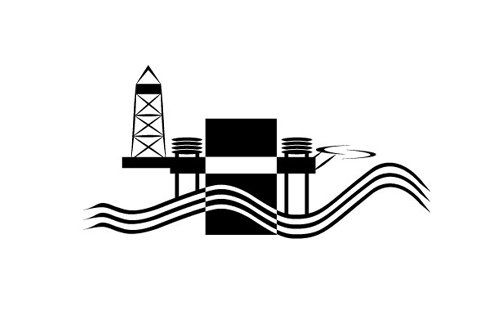

Science and Technology
MOHOLE – Phase I
2008
In 1957, Walter H. Munk, a member of the National Science Foundation (NSF) Earth Sciences Panel, proposed drilling through the earth’s upper crust to sample the Mohorovicic discontinuity, known as the Moho. The discontinuity separates the earth’s crust layer from the earth’s mantle. The mantle is believed to be approximately 1,800 miles thick, encapsulating the earth’s core. Sampling the Moho and the adjoining mantle would provide new scientific information related to the earth’s origin.
The earth’s crust averages about 125,000 feet thick under the continents, but is only 15,000 to 20,000 feet thick under the deeper ocean basins. Consequently, Dr. Munk and his fellow scientists believed the drilling program should be carried out in the ocean using a floating drilling vessel. Another scientist, Willard Bascom, became very interested in the ‘Mohole’ project and took over leadership of a group seeking NSF funding to perform a $15,000 feasibility study. Once NSF agreed to pay for the 1958 study, Willard Bascom’s group commenced working with Global Marine’s Robert Bauer on the design adaptations necessary for Global’s CUSS I drillship to perform anchorless coring operations. They proposed conducting the tests in 11,600 feet of water to demonstrate the feasibility of performing actual drilling operations in the very deep ocean.
In March 1960, the NSF approved the CUSS I’s modification funding and in March 1961 the CUSS I successfully took the first core penetrating 110 feet into the top of the earth’s crust. The coring was done utilizing manually controlled dynamic positioning in 11,700 feet of water near Guadalupe Island, off the West Coast of Baja, California. The Phase I program resulted in 5 holes, some penetrating over 1,000 feet, and retrieving 28 scientifically valuable cores. The cores included 44 feet of volcanic rock, which was the first time in history the hard rock of the earth’s crust had been penetrated. Phase I was the beginning of ultra deepwater drilling and successfully demonstrated that the Mohole could be drilled.
Recognizing the pioneering efforts of the following individuals and companies that contributed to this technology:
Willard Bascom, Robert Bauer, Walter H. Munk Global Marine (now Transocean), National Science Foundation
Mohole Phase II
2009
Project Mohole was a U.S. government-sponsored effort in the late 1950s and early 1960s to drill down to the earth’s lower crust and upper mantle to learn more about the interior composition and geologic history of the planet. Mohole produced technological and scientific innovations vital to the offshore industry and to the nation as a whole. During the 1960s, many segments of the offshore industry worked with Brown & Root on the project to develop path-breaking drilling technology capable of exploring a realm familiar only to science fiction, the earth’s crust. In the process, Brown & Root Marine gained valuable project management experience. As a manager of Project Mohole’s Phase II, Brown & Root showed off its skills in offshore and onshore engineering and design and demonstrated how commercial technology can be applied, modified, refined, and invented for scientific study.
Mohole contemplated something almost unimaginable for the time – drilling in 15,000 to 18,000 feet of water, and then through another 25,000 feet of the earth’s crust to the mantle. The maximum water depth drilled in those days, it must be remembered, was only about 200 feet. Although politics, scientific arguments, and the Vietnam War brought an end to Phase II in 1966, Project Mohole led to engineering and design innovations that benefited both the study of geophysics and the commercial offshore drilling industry.
Recognizing the pioneering efforts of the following individuals that contributed to this technology:
George Brown, Herman Brown, Jules N. Biron, Frank Briggs, Joe Lochridge,
Alan McClure, Rick Rochelle, Bill Schneider, Bill Tonking, Bowman Thomas, Bill Walker
First Generation Dynamic Position (DP) Vessels
2009
After successful coring offshore California in the 1950’s using spread mooring systems, the National Science Foundation (NSF) needed a stationkeeping system for deeper waters. In March 1961 the converted 3,400 LT drilling vessel Global Marine CUSS 1 recovered 28 geological cores from 5 holes in 11,700 ft. water depth using manual controlled steerable thrusters. Although the test was successful it showed that manual thruster control was very difficult. Concurrently Shell Oil Co. decided to build the 400 LT Eureka with two 200 Hp steerable thrusters with automatic lateral, longitudinal and heading resulting in successfully retrieved cores in up to 3,600 ft water depths in March 1961. In late 1967 Scripps Institution of Oceanography, sponsored by the NSF and other countries, accepted an offer from Global Marine to construct a 10,000 LT coring vessel (The Glomar Challenger) using digital computers. The vessel started operation in 1968 and cored throughout the world in up to 23,000 ft of water depth, contributing to the discovery of Global Tectonics. In 1971, Shell Oil and SEDCO put the newly constructed SEDCO 445 into operation as the first DP drilling vessel which used subsea BOPs and a drilling riser. This was closely followed by the IHC Holland DP vessel design and the first DP semi SEDCO 709.
These forerunners have led the industry to today’s DP positioned drilling, production, construction and pipe lay barges that can operate in over 10,000 ft. water depths.
Recognizing the pioneering efforts of the following individuals and organizations that contributed to this technology:
Willard Bascom, Bill Bates, Ron Dozier, John Graham, Dillard Hammett, George Lagers, Howard Shatto, Tom Stockton, Hank Van Calcar, Duke Zinkgraf, Baylor Company (now National Oilwell Varco), CFP (now TOTAL), General Motors, Global Marine (now Transocean), IHC Holland (now GustoMSC), Honeywell (now Nautronix), National Science Foundation, SEDCO (now Transocean) and Shell Oil Co.
Dynamic Positioning Reliability
2015
Initially, floating rigs were positioned by an array of anchors and cables. As water depths increased, these became uneconomical to install. In 1983, Shell selected the Sonat Offshore Discoverer Seven Seas with its Honeywell DP control system to conduct drilling in 7500 ft. of water off the East Coast of the US. Loss of position in those depths was economically prohibitive, and the risk of a possible oil spill was unacceptable. Because of these risks, Shell instituted a NASA-developed safety program called FMEA (Failure Mode Effects Analysis) raising the odds of failure to four years. In 1991, Sonat Offshore working with Simrad, further upgraded the DP system for the Discoverer 534, a sister rig using Simrad’s modular redundant control system to further increase failure possibility to over five years. By 1995, DP had become universally accepted.
Recognizing the pioneering efforts of the following individuals and organizations that contributed to this technology:
Q. Wayne Dean, Peter A. Fougere, Robert P. Herrmann, Dr. Nils Albert Jenssen, Howard L. Shatto, Henry Van Calcar, and Carl Wickizer
Honeywell Offshore Division (now Wartsila Marine Solutions), Shell, Simrad Inc. (now Kongsberg Maritime), and Sonat Offshore Drilling (now Transocean).
Spread Mooring System Analysis
2015
The need to predict spread-mooring systems’ capabilities to hold vessels on location grew with increasing water depths starting in the mid 1960’s. In 1969, a computer program was developed that could calculate mooring-lines configurations and forces with up to 12 lines of different compositions. Deepwater mooring systems were first used by Humble Oil and Refining in the late 1960’s in the Santa Barbara Channel. In 1973, the API Task Group on Mooring Gear was formed that led to a number of API RP’s. The dynamic effect of vessel motion and mooring line interaction was interjected into the spread mooring systems analysis using frequency and time-domain methods. The interaction of mooring and marine riser analysis and operation were developed in the late 1970’s. Since that time, the sophistication and detail of mooring analysis and its application has become an industry and government requirement.
Recognizing the pioneering efforts of the following individuals and organizations that contributed to this technology:
Roy B. Adams, Mark Childers, Chi-Tat Thomas Kwan, and Dr. Barry Miller
Exxon Production and Research Company (EPRCO), Global Maritime,
ODECO (now Diamond Offshore Drilling), and Netherlands Ship Model Basin



